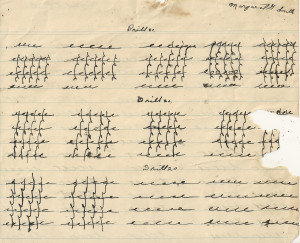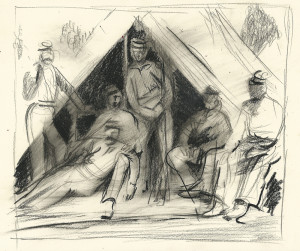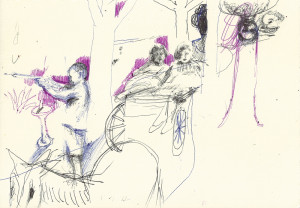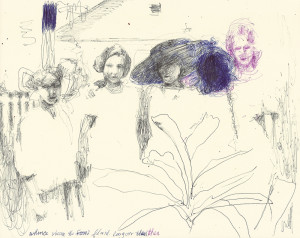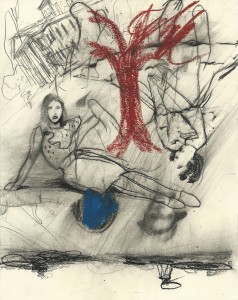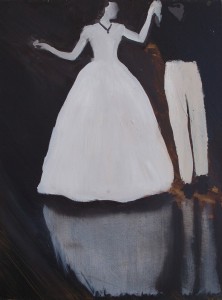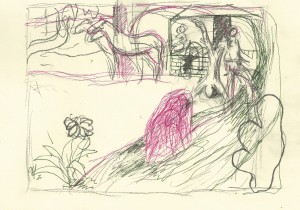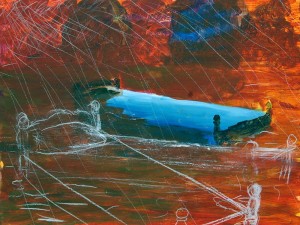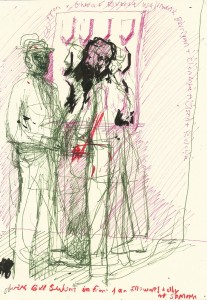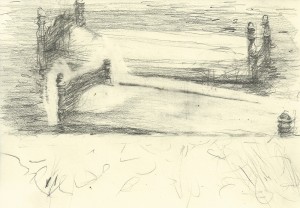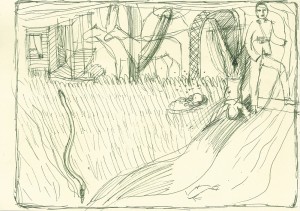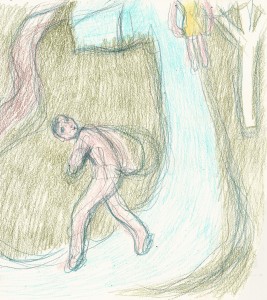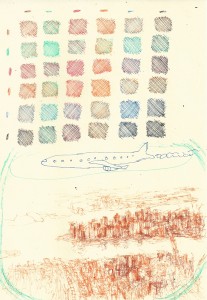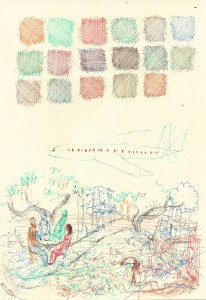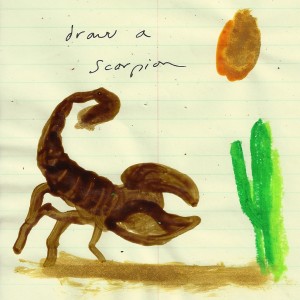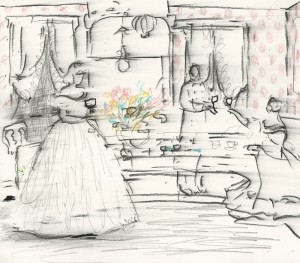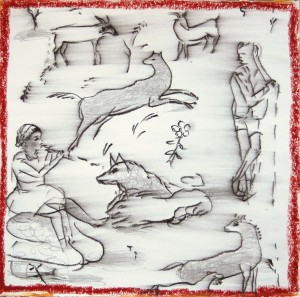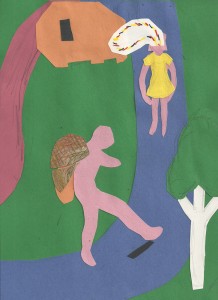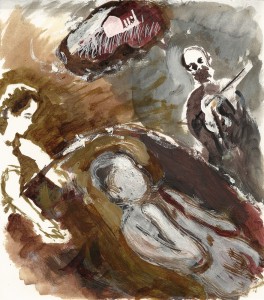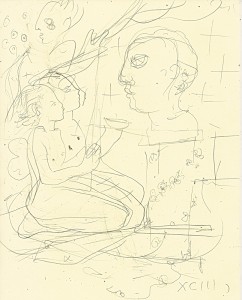Hush (Swords)
Hush Up
Hush (Drill)
18″ x 24″
I’ve had a policy of not including outside sources on the Work-a-day page, but this seems necessary.
On Sept 25, 1864, an ancestor of mine wrote a letter to her daughter from the family home ‘Sweet Auburn’ outside Natchez, Miss. To save paper, which was in low supply, the letter was cross-written. This is such an anomaly of Victorian letter writing, happened quite a bit during a time when formal letter writing was common, but paper was not, and postage expensive. The penmanship is so elegant, but when it’s written on top of itself it gets all jangled up. The writing, nearly indecipherable, is about the current (bad) state of things (war).
Then sixty-five years later, the letter writer’s great-great-granddaughter (my grandmother) was learning to write in her seventh grade class in Natchez. This is drill 20.
The ancestors keep giving me stuff to draw about, I’m barely touching the surface here. More cross-writing/drawing to come.
Related Images:
The Eighty-Ninth of May, 1930
This is a hard-boiled son of a gun, related in theme to a number of paintings I’ve done of orphans, frontal group portraits of children. Some of the children in the Orphans paintings may in fact be orphans for all I know, but more the point for me is that the source photographs are old enough to nearly ensure that all portrayed have all lived and died. Then it’s not the child, but the image of the child, that is the orphan.
The surface of this four foot square canvas has been worked and scraped many times over the last year, was nearly cut off the stretchers recently. Then I saw a grainy photograph of my great uncle’s second grade class that was recently published in the Baton Rouge newspaper. The caption recalls the two-room school house, the mule-drawn bus, the hand-me-downs. I put the canvas back on the easel again and they hopped right on.
Related Images:
Fern
Bees Took a Balustrade Down
Rabbit Bunny Hare Hare
Pecans
This drawing is based on two dimly xeroxed ancestral photographs taken by a family member in the 1910’s.
I recently read that Faulkner said his writing was a process of “sublimating the actual into the apocryphal.” One of the aspects I love about drawing is that its connection to ‘reality’ is always spurious. As it references one actuality, it simultaneously creates another, separate actuality.
Related Images:
Sources and Expenditures
The snake is saying, “For me, drawing is a source of energy, while painting is the expenditure of energy.” I really have to say that’s my experience as well. As much as they have over-lapping concerns, the stylus and the brush are very different instruments and when I go looking for how an artist thinks, I look at their drawings. It’s like looking at their drawings gets you closer to the source of what motivates their ideas.
Related Images:
Twisting My Beard
This one I’m twisting my beard, a nervous habit I can’t seem to break (though I honestly haven’t tried). Self-portraits often strike me as sad. I don’t make self-portraits very often, but I like seeing other people’s self-portraits. What a touching and awkward thing to record, studying and drawing one’s own face. I do love Jim Dine’s horribly awkward self-portraits. Rembrandt’s almost don’t count. Maybe my favorite self-portrait is old Bonnard in his later years, purple fists up in the bathroom mirror.
Related Images:
Weevil Sanders Goes to Town
Why Is Six Afraid of Seven
Because seven ate nine. On another note, the word stylus comes to us from Etruscan, as few words do.
Recently talking with Bill B. about polysemy and open meanings in drawing and writing. He said about one poem “as much polysemy as the poem can bear.” (phrasing taken from something Jane Freilicher said, about wanting “as much light as the painting can bear”).
Related Images:
Of the Federal Occupation
Further Than Town
They Go To Town They Go Further Than Town
Periodic Companions #14
Sugar Ants in the Cracker Pail
Nightfall in the Switch-cane
Where Is That Emmaline?
Chicken & a Beard Man
Clearing on the Road to Shurbutee
Save a Song for Sunday
Bagworms and Lollipops
Miss Ethel Fetch Them Tattle Treats
Whence the Florid Languor
A Stone Thus Inscribed
How You Want the Pigtail Done
Sing Sally Sally Hold the Shovel
Mrs. So and So Ferryboat A-Coming Sidelong
Road to Shubutee (sketch)
Collaborative Frieze
Bed in the Yard
Going to Shubuta
The origin of this image is an ancestral memoir recounting a journey from Natchez, Miss. to Shubuta, Miss. in 1863.
“The party consisted of my Mother and myself, my uncle George N. Monette and my cousin Billy Phillips and my Negro nurse Emeline Netter. Although I was less than two years old at the time, I can recall as if yesterday little incidents of that journey, – the drive over rough country roads through the great forests of virgin long-leaf Pine which then covered that part of the State, the stopping at times to rest and eat lunch under the shade of the trees, and sometimes at farm houses in the “clearings,” – my uncle and cousin jumping from the wagon and walking up the long hills to ease the tired wagon mules, and at last the meeting with my dear Father at the little town of Shubuta.”
Related Images:
Capsize
Cherries
Bed Barge in the Morning
Boxing with Cherry Hands
Couple
Ex Nihilo
Homesteaders
Themes Vary (Blue Breathing)
Wastrels at the Beach, Oil
Helper
Bed Barges in the Rain
Six-Leg Deer and Clovers
Bed Barge, Storm Approaching
Bed Barge, Pink Light
Dog With Head Funnel in Fort Mason Park
Presidio
Talking With Bill Berkson in Front of an Ellsworth Kelly
“You collaborate with your peers, either directly (that is, you write works together) or not (that is, by parallel creations you form the work that comes to be recognized as that of a period style, the art of your time). Competitiveness is a form of collaboration. Addressing an audience—conceiving an addressee, a reader or viewer, for the work—you collaborate with that shifting phantasmagoria. Such sociability is what puts the work in the world.” — Bill Berkson, from “Working with Joe,” 2002
It’s these broad definitions of collaboration that gives me hope. Sociability, generosity and conversation at the heart of art-making and art-viewing softens the sense that the Art-World is a fractured and self-important megalith. I had an uplifting morning with Bill Berkson at SFMOMA; this isn’t a great drawing necessarily but captures the conversation as I experienced it. And the Ellsworth Kelly room was elegant.
Related Images:
Dogs
Washington Parting the Delaware
It Is As If It Is On An Ox
Bed Barges and Scratches
Mule Deer’s Pink Lady
Three Figures, Two Horses and a Tree
Blue Stars at Night
From Tolstoy
The Beards of the Ancients
Paul Klee
Watersnake
à la plage
Cocktail Bar, Multi-Colored
Nine Faces
Rattler
Cocktail Bar
Pioneers in Yellow, Red, Blue
Pioneers with Woman Upside-down
Second Story Window
Live Oak IV.
Live Oak III.
Live Oak II.
Live Oak I.
Wheel Barrow
Trailer
Pioneers in the Dark
Color Circles
Eel
Walk
Color Blocks and Gold Manhattan
Garden District
Draw a Scorpion
In a book on the British painter Ken Kiff, the author refers to Art as a ‘species of Philosophy.’ I like this but wonder if there is more nuance. I think of what I do as a species of Philosophy, or sometimes a mutant relative of Linguistics, or sibling of literature. Seen from a certain angle, Painting could be considered a ‘species of Interior Design.’ Grouping like that helps me stay clear of the vortex of seeing one medium as in competition with another.
When I was in Glasgow, Painting was of no consequence, but Video Installation was of vital importance, now Social Practices (which could be seen as a ‘species of Activism’) is making Video Installation look like basket-weaving, and Painting is no longer a threat. Activism is seen as morally superior to intellectual pursuits now – not to mention the collecting of art objects – so Art that engages social issues and justice is at the top of the wheel for the moment. Will be interesting to watch the Art establishments domesticate Social Practices; reminds me of that quote from Octavio Paz: “More astute than Rome, the religion of art has absorbed all schisms.”
The above drawing: I made a note to myself and then did it, right there on the same page. Rare that happens in life.
Related Images:
Two Beds Upright Make an A
Largest Prairie Dog in the World
Thirty-Six Inch Long Donkey
Incredible Six-Legged Steer
Before exit 70 on the interstate that runs the length of Kansas there is a series of signs tempting one to pull off and admire the “incredible six-legged steer.” I just came across some notes I had drawn while driving (I know) and worked them up into more developed drawings. Maybe interesting for those who follow the Wastrels saga on this page, clearly the genesis of the eight-leg deer . . .
The next few drawings are of related oddities of beast at the same exit.
Related Images:
Salut
Wastrelius Romanus
Fire Ants
Coming Home
Cilice’s Dream
Panopticon
Making a Painting
Trike
Panther
Habemus Papam
Wastrels XCIII: I’m Not Asking You, You, I, and About the Middle of Your Heart
I do not want to close, and to worship, but you have my ears pierced. Sacrifices and sin offerings you will not, therefore, behold, I come from, we told him. The head of the book is about. I’m not asking you, you, I, and about the middle of your heart.
(this text is a mutation of Psalm 40:6-8, having translated the excerpt using Google Translate from English to Italian, Danish, Latin, Turkish, Bengali, Finnish, Hebrew and back to English)





